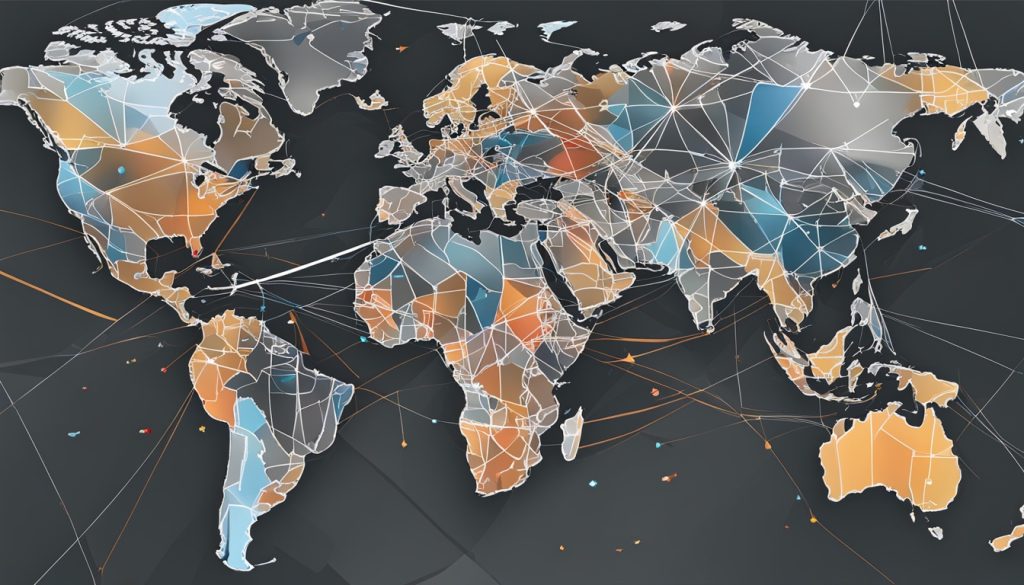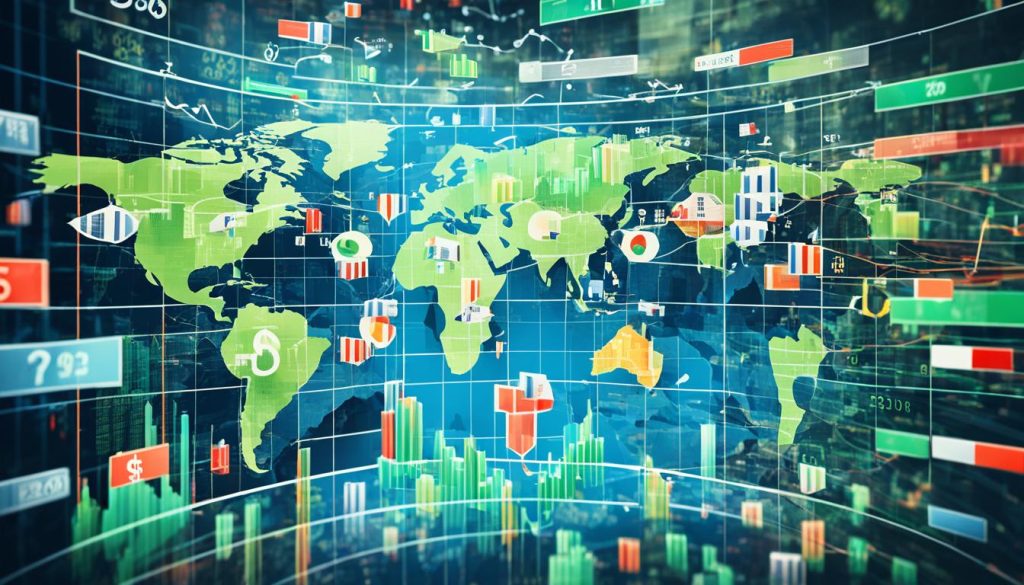In today’s world, investing in international markets is more appealing than ever for those looking to grow their money. By looking beyond your own country, you can find new chances for growth. This includes both developed economies full of new ideas and emerging markets ready to grow fast1.
Whether you’re careful with your investments or like to take bigger risks, going global can be a smart move1. By investing in different places, you can lower the ups and downs in your investments. This could lead to better returns over time.
But, investing in international markets can be tricky. You need to know about the risks like currency changes and political issues1. You also need to learn about the different ways to invest. With the right planning and knowledge, you can make the most of global investing.
Key Takeaways
- International investing can provide access to a wider range of growth opportunities and diversification benefits.
- Investing in foreign stocks, bonds, and other assets can help tap into the potential of developed and emerging economies.
- Careful consideration of risks, such as currency fluctuations and political instability, is crucial for successful global diversification.
- Understanding the various investment vehicles, including mutual funds, ETFs, and ADRs, can help navigate the international investing landscape.
- Developing a strategic approach to international diversification can help maximize the benefits while managing the risks.
By taking on international markets, you can start a journey that could lead to more growth and a stronger portfolio. With the right knowledge and a good plan, the world outside your country can open doors to success.
The Importance of International Diversification
Adding international assets to your investment portfolio can help lower the risk of losing money2. It also lets you tap into growth in new markets2. By investing outside the US, you can see how different markets perform, not just the US one.
Reducing Portfolio Volatility through Global Exposure
Vanguard suggests putting at least 20% of your investments in international stocks and bonds for better diversification2. You might consider 40% of your stocks and 30% of your bonds in these markets2. About 15% to 20% of these markets are in developed countries, and another 15% to 20% are in emerging markets2. Developed markets tend to be less unpredictable, offering a narrower range of possible gains2.
Accessing Untapped Growth Potential in Emerging Markets
Investing in places like India, China, and Brazil can lead to faster economic growth and higher returns, but it comes with more risk2. In recent years, some international markets did worse than the US market, but others did better3. Mixing developed and emerging markets in your portfolio can boost your long-term earnings while keeping risks in check.
| Index | 2023 Return | Volatility (10-year standard deviation) |
|---|---|---|
| Morningstar US Market Index | 26% | 15.5 |
| Morningstar Global Markets ex-US Index | 16% | 15.0 |
| Morningstar Emerging Markets Index | 12% | N/A |
| Morningstar Developed Markets ex-US Index | 18% | N/A |
European stocks seen as emerging had a low link with the US market by 2023, showing the value of spreading out your investments3. The Chinese economy, a big part of emerging markets, moves differently from the US, offering chances for unique returns3.
“Emerging-markets equities’ low correlation with US stocks is considered more enduring due to distinct economic cycles and geopolitical factors affecting emerging markets.”3
Putting some of your money into international and emerging markets can help increase your long-term gains while reducing risks.
But remember, international investing comes with its own challenges, like higher fees and risks from political issues in some countries4. Knowing these things can help you make smart choices and grow your portfolio over time.
Understanding International Investment Vehicles
As a U.S. investor, you have many ways to invest in global markets and diversify your portfolio. Mutual funds and exchange-traded funds (ETFs) make it easy to get into international stocks and bonds with low investment amounts5. These funds can follow global indexes or focus on certain regions or countries. This gives you options to meet your investment goals.
American Depositary Receipts (ADRs) are another choice. They are U.S.-traded securities that represent shares in foreign companies. This lets you invest in international stocks on U.S. exchanges5. ADRs are more transparent and liquid than trading on foreign markets, making them easier for many investors.
Mutual Funds and ETFs: Hassle-Free Global Exposure
Mutual funds and ETFs make it easy to diversify your portfolio with international investments. They hold a mix of stocks, bonds, and other assets from around the world. When picking a mutual fund or ETF, look at its strategy, fees, and past performance to match your investment goals and risk level.
American Depositary Receipts (ADRs): Trading Foreign Stocks on U.S. Exchanges
ADRs let you invest in foreign companies without the hassle of trading on international exchanges. These securities are in U.S. dollars and trade on U.S. exchanges. This makes them more transparent and liquid. By investing in ADRs, you can tap into the growth of global companies in the familiar U.S. market.
Knowing about these international investment options can help you make smart choices. It can lead to a well-diversified portfolio that meets your long-term financial goals5. Using these options can help you benefit from global markets and find new investment opportunities.

| Investment Vehicle | Key Features | Advantages | Considerations |
|---|---|---|---|
| Mutual Funds |
|
|
|
| Exchange-Traded Funds (ETFs) |
|
|
|
| American Depositary Receipts (ADRs) |
|
|
|
“Investing in international markets can open up a world of opportunities, but it’s important to understand the unique characteristics and considerations of different investment vehicles.”
Exploring mutual funds, ETFs, and ADRs can help you tailor your international investing to your risk tolerance, goals, and market outlook5. Research and understand these options to make informed decisions and potentially boost your portfolio’s long-term growth.
international investing, global markets, foreign investments
International investing is a key strategy for investors wanting to grow their money. It lets you spread your investments across the globe. This way, you can lower risks and reach new growth areas. It’s a chance to explore markets beyond the U.S.6
Experts say international stocks might do better than U.S. stocks over the next two decades7. Emerging markets are seen as key for economic growth and profits in the future7. These markets are expected to make up half of the world’s GDP in 20 years, up from 40% now and 25% before7.
Investors have many options to get into global markets. You can look at mutual funds, ETFs, or American Depositary Receipts (ADRs)6. These options make it easy to invest in foreign markets and grow your money6.

But, investing abroad comes with its own risks. You could face issues with currency values, political changes, and different rules8. You might also deal with different taxes on dividends from foreign stocks8. But, you might get special tax breaks for some foreign stock dividends8. It’s important to think carefully and plan well to make the most of your investments while avoiding risks8.
When you dive into international investing, global markets, and foreign investments, remember a varied portfolio is key. It helps you handle the ups and downs of the global economy. By taking advantage of international markets, you can find new ways to grow your money and make your financial future stronger.
Developed vs. Emerging Markets: Weighing the Risks and Rewards
When you invest globally, knowing the differences between developed markets and emerging markets is key. Developed markets like the United States, United Kingdom, and Japan are stable with strong economies. They usually have less risk and a smaller range of possible returns9.
Emerging markets, such as China, India, and Brazil, are growing fast but are also riskier. They offer the chance for big gains but come with more ups and downs910.
Developed and emerging markets have shown big differences in performance lately10. In early 2024, the MSCI Emerging Markets Index dropped 4.7%. But the S&P 500 and MSCI World Index did well, going up by nearly 11% and 9%, respectively10. This shows why it’s important to think about the risks and rewards of each market carefully.
“Emerging markets usually give investors higher returns because they’re growing fast. But, investing in them can be riskier. This is because of things like political instability, not enough reliable info, currency changes, less liquidity, and more investment ups and downs.”9
Understanding the differences between developed and emerging markets helps you make better investment choices. It lets you take advantage of global diversification while managing risks91011.
Currency Risks and Hedging Strategies
Investing in international markets can help diversify your portfolio and tap into global growth. But, you need to watch out for currency risk. This is the chance that the value of your investments could go up or down because of changes in exchange rates12. If the U.S. dollar gets stronger, your investments in other countries might lose value when you convert them back to dollars. On the other hand, a weaker dollar could make your international investments more valuable12.
Managing Fluctuations in Exchange Rates
To deal with currency risk, you can use hedging strategies. These include putting money into currency-hedged international funds or using derivatives like currency forwards or options12. Currency ETFs can also help reduce the effect of currency exchange rates on your portfolio12. Options contracts give you the chance to buy or sell a currency at a set rate, but they come with a fee12. Currency-based ETFs have a 1% fee12. Forward contracts let you lock in an exchange rate but require a deposit with the broker12.
Using hedging strategies can help keep the value of your international investments stable and lessen the impact of exchange rate changes on your portfolio12. Options contracts give you the right to buy or sell a currency at a specific rate, but you must think about the cost of the option premium12.
Currency risk can greatly affect foreign investments, making their value go up or down13. To protect against this, you can use currency futures to lock in current exchange rates and reduce potential losses from rate changes13. Traders can bet on how a currency will do against another, depending on their predictions13.
Currency hedging involves buying or selling futures contracts, with daily updates and cash margins needed13. You can invest in the currency market through brokers, funds, or ETFs focused on currency trading13. These investments can have different tax rules, costs, and benefits, so it’s important to consider things like trading fees and taxes when planning your investments13.
“Currency hedging is a strategy to mitigate the impact of currency or foreign exchange (FX) risk on international investments returns.”14
Predicting currency movements is hard because they can change a lot, like waves14. Currency volatility can really affect your investments in international markets over time14. A 30% drop in a portfolio can take years to get back, depending on how fast it grows14. Using fully hedged ETFs can make your portfolio less volatile14. Dynamic hedged ETFs try to make money when currencies help returns and avoid them when they don’t14.
When choosing hedging strategies and tools, think about how they can help manage currency risks and protect your international investments. By understanding and dealing with currency fluctuations, you could boost the long-term growth of your global portfolio121314.,,
Asset Allocation: Finding the Right Balance
Deciding how much to invest in international markets is key to good investment planning. Experts suggest that those who are cautious should put 5-10% of their money into international assets. Those who are more daring might aim for up to 25%15. This mix helps you benefit from investing globally while keeping risks in check15.
Your investment choices should match your financial goals, how much risk you can handle, and your current asset mix. Keeping an eye on your international investments and adjusting them as needed helps keep your portfolio in line with your goals15.
| Portfolio Type | Recommended International Allocation |
|---|---|
| Conservative | 5-10% |
| Aggressive | Up to 25% |
Building a diverse portfolio means looking at different types of assets and their risks and rewards16. Spreading your investments across various sectors and regions can make your portfolio more stable and potentially increase returns15.
- Large-Cap Stocks: Market capitalization above $10 billion16
- Mid-Cap Stocks: Market capitalization between $2 billion and $10 billion16
- Small-Cap Stocks: Market capitalization less than $2 billion16
- Emerging Markets: High potential return and high risk16
- Fixed-Income Securities: Less volatile and risky than stocks16
- Real Estate Investment Trusts (REITs): Shares in investor pools of mortgages or properties16
Think about your investment goals, how much risk you can take, and when you need the money to decide on a portfolio mix15. Regular checks and rebalancing your portfolio can keep it in line with your goals as things change16.
“A 60% domestic stocks and 40% international stocks allocation is suggested for reduced volatility in a portfolio.”15
Conclusion: Embracing Global Opportunities for Long-Term Growth
Investing in international markets can help you spread out your investments. It lets you reach new growth areas and boost your long-term earnings. By learning about the different markets and investment options, you can make a plan that fits your financial goals and how much risk you can take17.
International investing has its own challenges, like currency changes and different rules in each country. But, it also opens up a world of investment chances. This can be a big plus for a well-planned portfolio18. By taking advantage of global investment chances, you can set your investments up for growth over the long term.
The U.S. makes up 64% of global equities, and 74% of the top 50 companies are overseas. This shows there’s a big chance to diversify your portfolio and tap into global growth17. Also, foreign companies with high quality are often cheaper than U.S. ones by 34%. This could be a good chance for investors looking for value17.
FAQ
What are the benefits of investing in international markets?
Investing in international markets can boost your portfolio. It gives you access to more growth chances, spreads out your investments to lower risk, and may lead to better long-term gains.
How can international diversification help reduce portfolio volatility?
Adding international investments to your portfolio can lower its overall risk. This is because different markets around the world don’t always move together. This strategy can smooth out the ups and downs in your investments.
What are some ways to gain exposure to international and global markets?
U.S. investors can tap into international markets through mutual funds, ETFs, and American Depositary Receipts (ADRs).
What are the differences between investing in developed markets and emerging markets?
Developed markets are more stable, with strong industries and infrastructure. Emerging markets might offer bigger returns but also come with more risk and volatility.
How can investors manage currency risk in their international investments?
To handle currency risk, investors can use hedging tactics. This includes putting money into currency-hedged international funds or derivatives like currency forwards or options.
What is the recommended allocation to international investments within a portfolio?
Experts suggest that cautious investors put 5-10% of their portfolio into international assets. Those who are more risk-tolerant might aim for up to 25%.
Source Links
- 6 Ways to Invest in Foreign Stocks
- Why invest internationally? | Vanguard
- Where International Diversification Works—and Where It Falls Short
- International Portfolio: Definition, Benefits, and Risks
- Foreign Direct Investment (FDI): What It Is, Types, and Examples
- International Markets
- Investing | international stock outlook | Fidelity
- International Stocks
- Emerging Market Economy: Definition, How It Works, and Examples
- Outlook on Emerging Markets
- Emerging Markets Navigate Global Interest Rate Volatility
- Three Strategies to Mitigate Currency Risk
- Protect Your Foreign Investments From Currency Risk
- Currency Hedging Strategies | WisdomTree
- Making the case for international equity allocations
- How to Achieve Optimal Asset Allocation
- International equities: The rest of the world’s comeback
- The Future of Finance and the Global Economy: Facing Global Forces, Shaping Global Solutions

